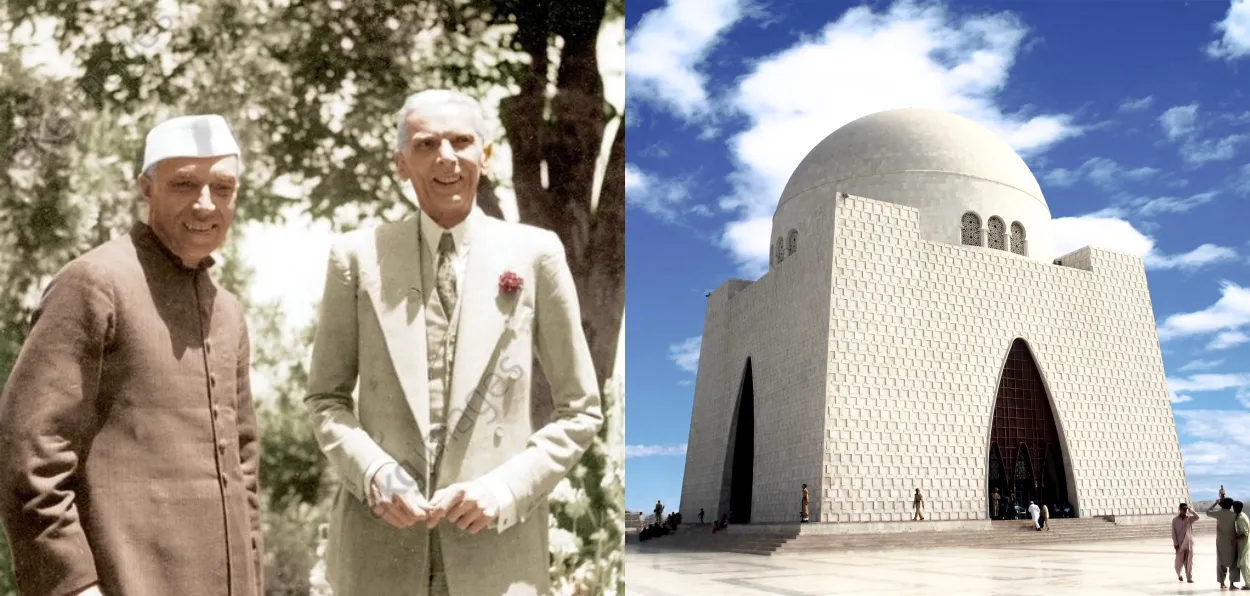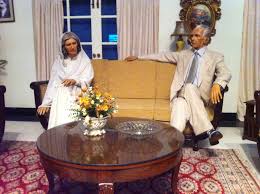
Mansooruddin Faridi/New Delhi
Pakistan's founder, Muhammad Ali Jinnah, had a traumatic last day. Frail and sick with pneumonia, he flew in from Quetta to Karachi on doctors' advice. His limousine broke down on the way from the airport, and he, along with his sister and companion Fatima Jinnah, had to wait for an hour on the roadside in sweltering heat due to the delay in authorities sending a replacement. He died the same evening, September 11, 1948, in a Karachi hospital.
The towering leader who had carved out a new nation, barely a year before his death, had to face pain, discomfort, humiliation and neglect in his final hours. But there was more awaiting him.
A token monument to perpetuate the memory of the nation's founder took 12 years to get into shape, that too after a historic rebuke by India's Prime Minister Jawaharlal Nehru to Pakistan's President Gen Ayub Khan.

Jawaharlal Nehru with Pakistani President Ayub Khan
Nehru visited Pakistan in 1960 to finalise the Indus Waters Treaty on the sharing of rivers between the two countries. He travelled to Karachi to sign the agreement and, during his stay, expressed a desire to pay homage to his former colleague Jinnah at his grave.
Nehru was shocked to see that 12 years after his death, Jinnah's grave was undeveloped and covered with a tarpaulin tent.
Recently, a Pakistani intellectual, Kamil H. Mian, shed light on the connection with Nehru and what today stands as Mazar-e-Quaidi - the marble mausoleum of Jinnah - in Karachi. His video interview went viral on social media.
Kamil Mian says that, in 1960, the current site of Mazar-e-Quaid was a patch of barren land with a tent and a dirt road, in a poor locality of Qaidabad.

Jawaharl Lal Nehru being welcomed by locals in Karachi in 1960
Nehru quietly visited Jinnah’s grave, stood in silence for a few moments, offered his respects, and left without saying a word. The next day, when he met President Ayub Khan, he reportedly said in a tone of disappointment, “I visited Jinnah’s grave - the man who would not tolerate a speck of dust on his suit - and you have left him in such a condition? I did not expect this from you people.”
These words left Ayub Khan embarrassed. He immediately convened a cabinet meeting and ordered that Jinnah’s resting place be rebuilt in a manner befitting the founder of the nation. It was this decision that accelerated the construction of the Mazar-e-Quaid we see today.
Kamil Mian further mentions that Karachi’s Commissioner Syed Hashim Raza played a crucial role in designing and overseeing the construction of the mausoleum. He had long advocated that Jinnah’s tomb should be located in a most prominent place, where all of Karachi could see it - symbolising the founder’s eternal watch over his nation. However, his proposals were ignored until Nehru’s remarks jolted Ayub Khan into action.

Muhammad Ali Jinnah and his siter Fatima Jinnah
In fact, in 1949, the Quaid-e-Azam Memorial Fund was established for Jinnah's tomb. The fund was controlled by Jinnah's sister, Fatima Jinnah. Interestingly, the tomb was designed by Mumbai architect Yahya Merchant, who was a friend of Jinnah.
Ayub Khan laid the foundation stone of this monument on July 31, 1960. This was the time when Nehru had scolded President Ayub Khan in Pakistan for the state in which Jinnah had been left after his death. It was inaugurated by another President, Yahya Khan, on January 18, 1971. But there is also a fact that the gardens around the tomb were not completed until December 24, 2000.
Kamil Mian concludes that had Nehru not rebuked Ayub Khan, Jinnah’s grave might have remained in that same neglected state. “If Nehru hadn’t visited Karachi in 1960 or made that comment, there might never have been a Mazar-e-Quaid,” he asserts.
The video also recalls that when Jinnah died in 1948, Karachi’s Municipal Commissioner, Syed Hashim Raza, had painstakingly searched for a burial site. The area where Jinnah was ultimately laid to rest - near the old exhibition grounds - spanned about 144 acres and was then home to thousands of refugees living in makeshift huts.
Nehru was angry after seeing Jinnah's dilapidated grave during the visit of Pakistan in 1960, he scolded Pakistani President Ayub Khan, then the Mazar e Quaid was completed-Pakistani Scholar
— mansooruddin faridi (@mfaridiindia) November 1, 2025
محمد علی جناح کا مزار نہرو کی ڈانٹ پھٹکار کے بعد مکمل ہوسکا #Jinnah #nehru #India #Pak pic.twitter.com/MF3tH8Xx3C
ALSO READ: Mukhtar Alam transformed crime den of Azad Basti into respectable locality
Pakistan’s first Prime Minister, Liaquat Ali Khan, asked Raza to resolve the matter, and he persuaded the settlers to vacate the land for Jinnah’s final resting place.
